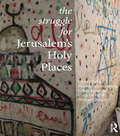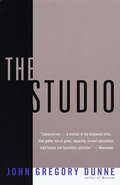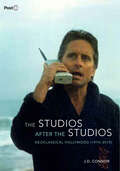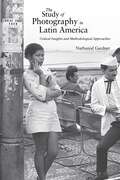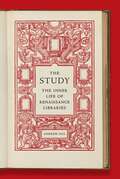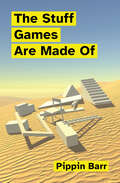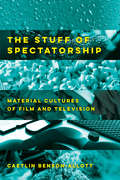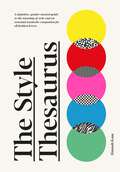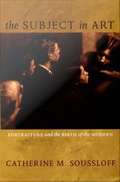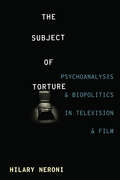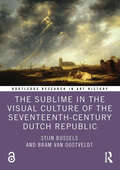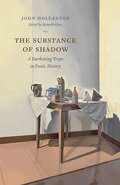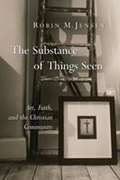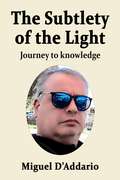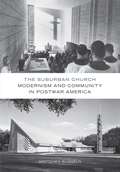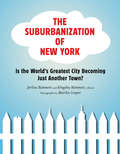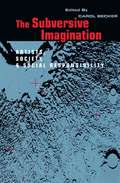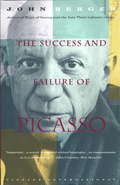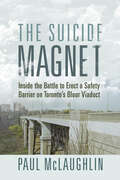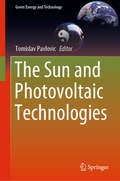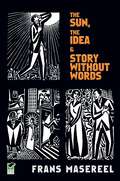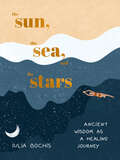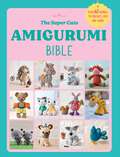- Table View
- List View
The Struggle for Jerusalem's Holy Places
by Michael Dumper Wendy Pullan Maximilian Sternberg Lefkos Kyriacou Craig LarkinThe Struggle for Jerusalem’s Holy Places investigates the role of architecture and urban identity in relation to the political economy of the city and its wider state context seen through the lens of the holy places. Reflecting the broad disciplinary backgrounds of the authors, this book provides perspectives from architecture, urbanism, and politics, and provides in-depth investigations of historical, ethnographic and policy-related case studies. The research is substantiated by fieldwork carried out in Jerusalem over the past ten years as part of the ESRC Large Grants project ‘Conflict in Cities’. By analysing new dynamics of radicalisation through land seizure, the politicisation of parklands and tourism, the strategic manipulation of archaeological and historical narratives and material culture, and through examination of general appropriation of Jerusalem’s varied rituals, memories and symbolism for factional uses, the book reveals how possibilities of co- existence are seriously threatened in Jerusalem. Shedding new light on the key role played by everyday urban life and its spatial settings for any future political agreements about the city and its religious sites, this book is a useful reference work for students and scholars of Middle East Studies, Architecture, Religion and Urban Studies.
The Studio
by John Gregory DunneIn 1967, John Gregory Dunne asked for unlimited access to the inner workings of Twentieth Century Fox. Miraculously, he got it. For one year Dunne went everywhere there was to go and talked to everyone worth talking to within the studio. He tracked every step of the creation of pictures like "Dr. Dolittle," "Planet of the Apes," and "The Boston Strangler." The result is a work of reportage that, thirty years later, may still be our most minutely observed and therefore most uproariously funny portrait of the motion picture business.Whether he is recounting a showdown between Fox's studio head and two suave shark-like agents, watching a producer's girlfriend steal a silver plate from a restaurant, or shielding his eyes against the glare of a Hollywood premiere where the guests include a chimp in a white tie and tails, Dunne captures his subject in all its showmanship, savvy, vulgarity, and hype. Not since F. Scott Fitzgerald and Nathanael West has anyone done Hollywood better."Reads as racily as a novel...(Dunne) has a novelist's ear for speech and eye for revealing detail...Anyone who has tiptoed along those corridors of power is bound to say that Dunne's impressionism rings true."--Los Angeles Times
The Studios after the Studios: Neoclassical Hollywood (1970-2010)
by J. D. ConnorModern Hollywood is dominated by a handful of studios: Columbia, Disney, Fox, Paramount, Universal, and Warner Bros. Threatened by independents in the 1970s, they returned to power in the 1980s, ruled unquestioned in the 1990s, and in the new millennium are again beseiged. But in the heyday of this new classical era, the major studios movies — their stories and styles — were astonishingly precise biographies of the studios that made them. Movies became product placements for their studios, advertising them to the industry, to their employees, and to the public at large. If we want to know how studios work—how studios think—we need to watch their films closely. How closely? Maniacally so. In a wide range of examples, The Studios after the Studios explores the gaps between story and backstory in order to excavate the hidden history of Hollywood's second great studio era.
The Study of Photography in Latin America: Critical Insights and Methodological Approaches
by Nathanial GardnerIn this book Nathanial Gardner provides an insider&’s perspective to the study of photography in Latin America. He begins with a carefully structured introduction that lays out his unique methodology for the book, which features over eighty photographs and the insights from sixteen prominent Latin American photography scholars and historians, including Boris Kossoy, John Mraz, and Ana Mauad. The work reflects the advances and developments of the study of photography throughout Latin America with certain emphasis on Brazil and Mexico. The author further underlines the role of important institutions and builds context by discussing influential theories and key texts that currently guide the discipline. The Study of Photography in Latin America is critical to all who want to expand their current knowledge of the subject and engage more robustly with its experts.
The Study: The Inner Life of Renaissance Libraries
by Andrew HuiA uniquely personal account of the life and enduring legacy of the Renaissance libraryWith the advent of print in the fifteenth century, Europe&’s cultural elite assembled personal libraries as refuges from persecutions and pandemics. Andrew Hui tells the remarkable story of the Renaissance studiolo—a &“little studio&”—and reveals how these spaces dedicated to self-cultivation became both a remedy and a poison for the soul.Blending fresh, insightful readings of literary and visual works with engaging accounts of his life as an insatiable bookworm, Hui traces how humanists from Petrarch to Machiavelli to Montaigne created their own intimate studies. He looks at imaginary libraries in Rabelais, Cervantes, Shakespeare, and Marlowe, and discusses how Renaissance painters depicted the Virgin Mary and St. Jerome as saintly bibliophiles. Yet writers of the period also saw a dark side to solitary reading. It drove Don Quixote to madness, Prospero to exile, and Faustus to perdition. Hui draws parallels with our own age of information surplus and charts the studiolo&’s influence on bibliographic fabulists like Jorge Luis Borges and Umberto Eco.Beautifully illustrated, The Study is at once a celebration of bibliophilia and a critique of bibliomania. Incorporating perspectives on Islamic, Mughal, and Chinese book cultures, it offers a timely and eloquent meditation on the ways we read and misread today.
The Stuff Games Are Made Of (Playful Thinking)
by Pippin BarrA deep dive into practical game design through playful philosophy and philosophical play.What are video games made of? And what can that tell us about what they mean? In The Stuff Games Are Made Of, experimental game maker Pippin Barr explores the materials of video game design. Taking the reader on a deep dive into eight case studies of his own games, Barr illuminates the complex nature of video games and video game design, and the possibilities both offer for exploring ideas big and small.Through a variety of engaging and approachable examples, Barr shows how every single aspect of a game—whether it is code, graphics, interface, or even time itself—can be designed with and related to the player experience. Barr&’s experimental approach, with its emphasis on highly specific elements of games, will leave readers armed with intriguing design philosophy, conceptual rigor, and diverse insights into the inner life of video games. Upon finishing this book, readers will be ready to think deeply about the nature of games, to dive into expressive and experimental game design themselves, or simply to play with a new and expanded mindset.
The Stuff of Spectatorship: Material Cultures of Film and Television
by Caetlin Benson-AllottFilm and television create worlds, but they are also of a world, a world that is made up of stuff, to which humans attach meaning. Think of the last time you watched a movie: the chair you sat in, the snacks you ate, the people around you, maybe the beer or joint you consumed to help you unwind—all this stuff shaped your experience of media and its influence on you. The material culture around film and television changes how we make sense of their content, not to mention the very concepts of the mediums. Focusing on material cultures of film and television reception, The Stuff of Spectatorship argues that the things we share space with and consume as we consume television and film influence the meaning we gather from them. This book examines the roles that six different material cultures have played in film and television culture since the 1970s—including video marketing, branded merchandise, drugs and alcohol, and even gun violence—and shows how objects considered peripheral to film and television culture are in fact central to its past and future.
The Style Thesaurus: A definitive, gender-neutral guide to the meaning of style and an essential wardrobe companion for all fashion lovers
by Hannah KaneAt once a lexicon of fashion and a style guide, The Style Thesaurus is the essential wardrobe companion for all fashion lovers.Style can be used to fit in or to stand out, to send different messages and, with the right knowledge, it can also be adjusted according to mood or occasion. The Style Thesaurus examines a wide range of looks, investigates their roots in history and culture, and shows how they can be curated or combined.Organized into groups reflecting the origins of the style - Utility, Music & Dance, Leisure etc - and fully illustrated, each entry includes examples, near synonymous styles, styling details, pairings and colour story. Entries include everything from Neo-Victoriana, Dandy and Rockabilly to Normcore, Modest or Afrofuturist.
The Style Thesaurus: A definitive, gender-neutral guide to the meaning of style and an essential wardrobe companion for all fashion lovers
by Hannah KaneAt once a lexicon of fashion and a style guide, The Style Thesaurus is the essential wardrobe companion for all fashion lovers.Style can be used to fit in or to stand out, to send different messages and, with the right knowledge, it can also be adjusted according to mood or occasion. The Style Thesaurus examines a wide range of looks, investigates their roots in history and culture, and shows how they can be curated or combined.Organized into groups reflecting the origins of the style - Utility, Music & Dance, Leisure etc - and fully illustrated, each entry includes examples, near synonymous styles, styling details, pairings and colour story. Entries include everything from Neo-Victoriana, Dandy and Rockabilly to Normcore, Modest or Afrofuturist.
The Subject in Art: Portraiture and the Birth of the Modern
by Catherine M. SoussloffChallenging prevailing theories regarding the birth of the subject, Catherine M. Soussloff argues that the modern subject did not emerge from psychoanalysis or existential philosophy but rather in the theory and practice of portraiture in early-twentieth-century Vienna. Soussloff traces the development in Vienna of an ethics of representation that emphasized subjects as socially and historically constructed selves who could only be understood--and understand themselves--in relation to others, including the portrait painters and the viewers. In this beautifully illustrated book, she demonstrates both how portrait painters began to focus on the interior lives of their subjects and how the discipline of art history developed around the genre of portraiture. Soussloff combines a historically grounded examination of art and art historical thinking in Vienna with subsequent theories of portraiture and a careful historiography of philosophical and psychoanalytic approaches to human consciousness from Hegel to Sartre and from Freud to Lacan. She chronicles the emergence of a social theory of art among the art historians of the Vienna School, demonstrates how the Expressionist painter Oskar Kokoschka depicted the Jewish subject, and explores the development of pictorialist photography. Reflecting on the implications of the visualized, modern subject for textual and linguistic analyses of subjectivity, Soussloff concludes that the Viennese art historians, photographers, and painters will henceforth have to be recognized as precursors to such better-known theorists of the subject as Sartre, Foucault, and Lacan.
The Subject of Torture: Psychoanalysis and Biopolitics in Television and Film
by Hilary NeroniConsidering representations of torture in such television series as 24, Alias, and Homeland; the documentaries Taxi to the Dark Side (2007), Ghosts of Abu Ghraib (2007), and Standard Operating Procedure (2008); and "torture porn" feature films from the Saw and Hostel series, Hilary Neroni unites aesthetic and theoretical analysis to provide a unique portal into theorizing biopower and its relation to the desiring subject. Her work ultimately showcases film and television studies' singular ability to expose and potentially disable the fantasies that sustain torture and the regimes that deploy it.
The Sublime in the Visual Culture of the Seventeenth-Century Dutch Republic (Routledge Research in Art History)
by Stijn Bussels Bram Van OostveldtContrary to what Kant believed about the Dutch (and their visual culture) as “being of an orderly and diligent position” and thus having no feeling for the sublime, this book argues that the sublime played an important role in seventeenth-century Dutch visual culture. By looking at different visualizations of exceptional heights, divine presence, political grandeur, extreme violence, and extraordinary artifacts, the authors demonstrate how viewers were confronted with the sublime, which evoked in them a combination of contrasting feelings of awe and fear, attraction and repulsion. In studying seventeenth-century Dutch visual culture through the lens of notions of the sublime, we can move beyond the traditional and still widespread views on Dutch art as the ultimate representation of everyday life and the expression of a prosperous society in terms of calmness, neatness, and order. The book will be of interest to scholars working in art history, visual culture, architectural history, and cultural history. The Open Access version of this book, available at www.taylorfrancis.com, has been made available under a Creative Commons Attribution-Non Commercial-No Derivatives (CC-BY-NC-ND 4.0) 4.0 International license. Funded by Ghent University.
The Substance of Shadow: A Darkening Trope in Poetic History
by John Hollander Kenneth GrossJohn Hollander, poet and scholar, was a master whose work joined luminous learning and imaginative risk. This book, based on the unpublished Clark Lectures Hollander delivered in 1999 at Cambridge University, witnesses his power to shift the horizons of our thinking, as he traces the history of shadow in British and American poetry from the Renaissance to the end of the twentieth century. Shadow shows itself here in myriad literary identities, revealing its force as a way of seeing and a form of knowing, as material for fable and parable. Taking up a vast range of texts--from the Bible, Dante, Shakespeare, and Milton to Poe, Dickinson, Eliot, and Stevens--Hollander describes how metaphors of shadow influence our ideas of dreaming, desire, doubt, and death. These shadows of poetry and prose fiction point to unknown, often fearful domains of human experience, showing us concealed shapes of truth and possibility. Crucially, Hollander explores how shadows in poetic history become things with a strange substance and life of their own: they acquire the power to console, haunt, stalk, wander, threaten, command, and destroy. Shadow speaks, even sings, revealing to us the lost as much as the hidden self. An extraordinary blend of literary analysis and speculative thought, Hollander's account of the substance of shadow lays bare the substance of poetry itself.
The Substance of Things Seen: Art, Faith, and the Christian Community (Calvin Institute of Christian Worship Liturgical Studies)
by Robin JensenWhile the average person rarely sees it, the visual arts play a subtle yet profound role in the teaching and formation of faith, both for individuals and religious communities. The Substance of Things Seen explores the intersection of art and faith, offering thoughtful reflections on the way art functions in Christian life and practice. <p><p> Highly readable and featuring instructive illustrations, this book is meant to engage church leaders as well as artists in constructive conversation about the critical role that art can play in the renewal of Christian education, worship, and study. It also challenges anyone who thinks the arts are only of marginal importance to the religious life. Robin Jensen considers here a broad range of topics relevant to Christian faith and culture, including the construction of sacred space, the use of art in worship and spiritual formation, the way that visual art interprets sacred texts, and the power and danger of art from a historical and contemporary perspective.
The Subtlety of the Light: Journey to knowledge
by Miguel D'AddarioThe Subtlety of the Light is a book that summarizes a number of writings related to philosophical, altruistic, metaphysical and existentialist thoughts. It is approached through poetic forms, essays or profound testaments. Based on schools of existential knowledge and currents that analyze the presence of man on earth. To analyze and reflect, understand and conclude.
The Suburban Church: Modernism and Community in Postwar America (Architecture, Landscape and Amer Culture)
by Gretchen BuggelnAfter World War II, America&’s religious denominations spent billions on church architecture as they spread into the suburbs. In this richly illustrated history of midcentury modern churches in the Midwest, Gretchen Buggeln shows how architects and suburban congregations joined forces to work out a vision of how modernist churches might help reinvigorate Protestant worship and community. The result is a fascinating new perspective on postwar architecture, religion, and society.Drawing on the architectural record, church archives, and oral histories, The Suburban Church focuses on collaborations between architects Edward D. Dart, Edward A. Sövik, Charles E. Stade, and seventy-five congregations. By telling the stories behind their modernist churches, the book describes how the buildings both reflected and shaped developments in postwar religion—its ecumenism, optimism, and liturgical innovation, as well as its fears about staying relevant during a time of vast cultural, social, and demographic change.While many scholars have characterized these congregations as &“country club&” churches, The Suburban Church argues that most were earnest, well-intentioned religious communities caught between the desire to serve God and the demands of a suburban milieu in which serving middle-class families required most of their material and spiritual resources.
The Suburbanization of New York: Is the World's Greatest City Becoming Just Another Town?
by Jerilou Hammett Kingsley Hammett Martha CooperThe city that never sleeps also never stops changing. And while New Yorkers are renowned for their trendsetting, this thought-provoking book argues that New York City itself has become a follower rather than a leader. Once-distinctive streets and neighborhoods have become awash in generic stores, apartment boxes, and garish signs and billboards. Legendary neighborhoods (Little Italy, Hell's Kitchen, Harlem, the Lower East Side) have been smoothed over with cute monikers, remade for real-estate investment and for sale to the highest bidder.
The Subversive Imagination: The Artist, Society and Social Responsiblity
by Carol BeckerFirst Published in 1994. Routledge is an imprint of Taylor & Francis, an informa company.
The Success and Failure of Picasso (Vintage International)
by John BergerAt the height of his powers, Pablo Picasso was the artist as revolutionary, breaking through the niceties of form in order to mount a direct challenge to the values of his time. At the height of his fame, he was the artist as royalty: incalculably wealthy, universally idolized--and wholly isolated. In this stunning critical assessment, John Berger--one of this century's most insightful cultural historians--trains his penetrating gaze upon this most prodigious and enigmatic painter and on the Spanish landscape and very particular culture that shpaed his life and work. Writing with a novelist's sensuous evocation of character and detail, and drawing on an erudition that embraces history, politics, and art, Berger follows Picasso from his childhood in Malaga to the Blue Period and Cubism, from the creation of Guernica to the pained etchings of his final years. He gives us the full measure of Picasso's triumphs and an unsparing reckoning of their cost--in exile, in loneliness, and in a desolation that drove him, in his last works, into an old man's furious and desperate frenzy at the beauty of what he could no longer create.
The Suicide Magnet: Inside the Battle to Erect a Safety Barrier on Toronto’s Bloor Viaduct
by Paul McLaughlinThe inside story of the grassroots fight to have a suicide barrier erected on Toronto’s “bridge of death.”Most Torontonians have no idea their city once hosted the second most popular suicide magnet in North America, behind the Golden Gate Bridge. Since its completion in 1918, more than four hundred people jumped to their death from the Bloor Viaduct, which spans the cavernous Don Valley.That number might still be rising if not for the tireless efforts of a group of volunteers, led by two citizens, who fought City Hall for years to get a suicide barrier erected. Not only did they win, they saved numerous lives and brought to light valuable research on how barriers actually lower suicide numbers overall. The resulting barrier — The Luminous Veil — has been praised for its ingenious and inspiring design.The Suicide Magnet tells how the battle was won, and explores the ongoing efforts to help those suffering from mental health challenges.
The Summer of Jordi Perez (And the Best Burger in Los Angeles)
by Amy Spalding<p>Seventeen, fashion-obsessed, and gay, Abby Ives has always been content playing the sidekick in other people’s lives. While her friends and sister have plunged headfirst into the world of dating and romances, Abby’s been happy to focus on her plus-size style blog and her dreams of taking the fashion industry by storm. When she lands a great internship at her favorite boutique, she’s thrilled to take the first step toward her dream career. Then she falls for her fellow intern, Jordi Perez. Hard. And now she’s competing against the girl she’s kissing to win the coveted paid job at the end of the internship. <p>But really, nothing this summer is going as planned. She also unwittingly becomes friends with Jax, a lacrosseplaying bro-type who wants her help finding the best burger in Los Angeles, and she’s struggling to prove to her mother—the city’s celebrity health nut—that she’s perfectly content with who she is. <p>Just as Abby starts to feel like she’s no longer the sidekick in her own life, Jordi’s photography surprisingly puts her in the spotlight. Instead of feeling like she’s landed a starring role, Abby feels betrayed. Can Abby find a way to reconcile her positive yet private sense of self with the image others have of her?</p>
The Sun and Photovoltaic Technologies (Green Energy and Technology)
by Tomislav PavlovicThis book covers solar energy and the use of solar radiation in connection with lighting. It provides a detailed introduction to solar energy, photovoltaic (PV) solar energy conversion, and solar lighting technologies, while also discussing all of these elements in the context of the Balkan Peninsula. In the context of solar energy, the book covers a range of elements, from the structure of the sun, to PV solar plants. It subsequently addresses the status quo of solar technologies in Bulgaria, Serbia and the Republika Srpska and analyses the development of these technologies over the years, including their economic status, and how these aspects have shaped their current status. Undergraduate and graduate students, researchers and professionals, particularly those based in the Balkans, will find this book both informative and interesting.
The Sun, The Idea & Story Without Words: Three Graphic Novels
by David A. Beronä Frans MasereelRich in symbolism, these compelling graphic novels feature more than 200 starkly beautiful woodcut illustrations. The passionate, dynamic narratives include The Sun, a somber exploration of one man's struggle with destiny; The Idea, a depiction of the triumph of an artistic concept over attempts at its suppression; and Story Without Words, a tale of thwarted romance. <p><p> Belgian-born Frans Masereel illustrated the works of Tolstoy, Zola, and Oscar Wilde, but he made the greatest impact with his wordless novels. These three stories, dating from the early 1920s, reflect the German Expressionist revival of the art of the woodcut. Precursors to today's graphic novels, they also represent a centuries-old tradition of picture books for unschooled audiences. Masereel combines allegory and satire in his explorations of love, alienation, and artistic creation. Thomas Mann praised these striking Expressionistic images as "so compelling, so deeply felt, so rich in ideas, that one never tires of looking at them." <p> <i>Advisory: Bookshare has learned that this book offers only partial accessibility. We have kept it in the collection because it is useful for some of our members. To explore further access options with us, please contact us through the Book Quality link on the right sidebar. Benetech is actively working on projects to improve accessibility issues such as these.</i>
The Sun, the Sea, and the Stars: Ancient Wisdom as a Healing Journey
by Iulia BochisA beautiful visual representation of personal growth and healing based around striking affirmations, mantras, and ancient wisdom, from Lao Tzu to Rumi and beyondWhen it seems that you have been left behind, in a moment of stillness you might realize that the infinite stars, the restless sea, and the patient moon are all traveling along with you. In this beautiful collection, artist Iulia Bochis pairs visual storytelling with timeless wisdom to take you on a voyage of self-discovery through the seasons of life. Following a traveler as they face the changes of fall, the loneliness of winter, the hopeful nature of spring, and the happiness of summer, these pages capture the grief, transformation, healing, and growth we all experience on the journey toward self-love. Guided by Iulia&’s insightful words and punctuated with Zen proverbs and quotes from prominent thinkers from Lao Tzu to Rumi, this vibrantly illustrated book will inspire you to trust the process, find comfort in new beginnings, and reflect on the beauty and magic that exists in the world around you.
The Super Cute Amigurumi Bible
by Ebury PressThe biggest amigurumi book yet, with over 60 adorable animals to crochet, love and share – it’s the cat’s pyjamas!Grab your crochet hook and head to a cosy corner – it’s time to get stitching! Including everything from farmyard familiars to fantasy friends, this bumper book of 60 amigurumi patterns has something to make for everyone you know.Featuring straightforward, tried-and-tested instructions and a range of difficulties, this gorgeous book includes a project for every taste and ability.
